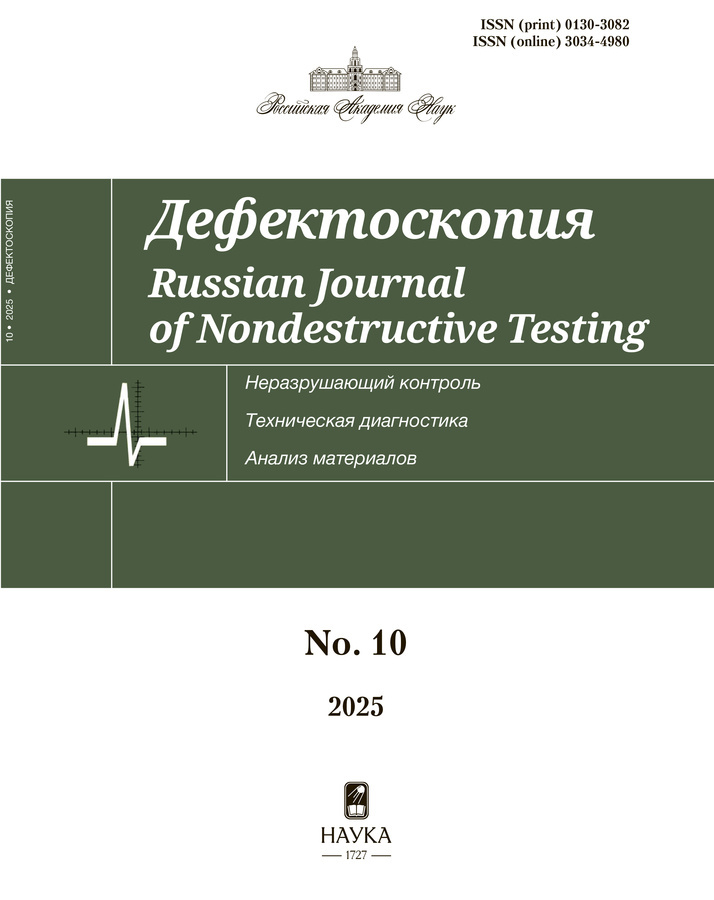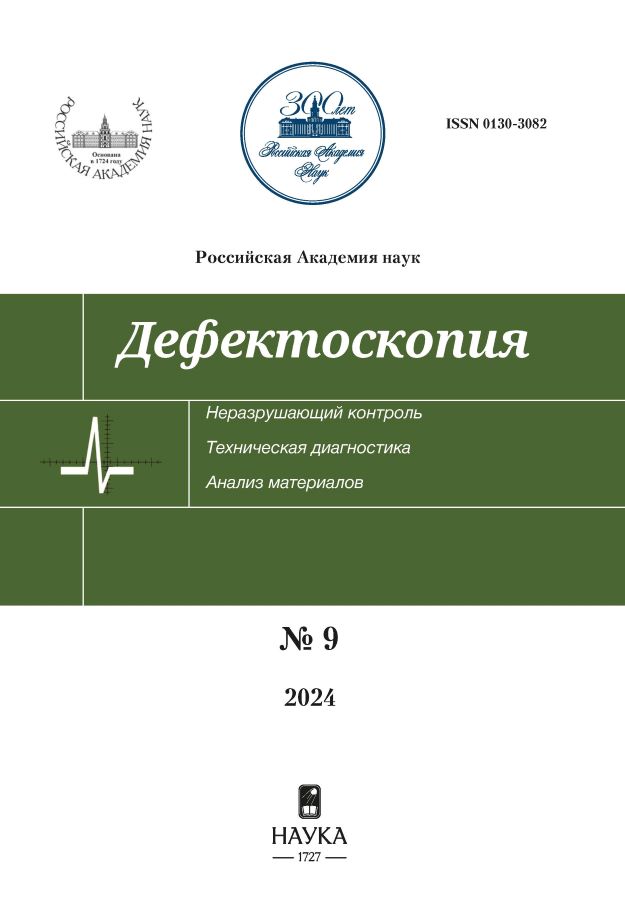Reconstruction of the shape of a flaw in ferromagnetic plate by solving inverse problem of magnetostatics and series of direct problems
- Authors: Nikitin A.V.1, Mikhaylov L.V.1, Mikhaylov A.V.1, Gobov Y.L.1, Kostin V.N.1, Smorodinskii Y.G.1
-
Affiliations:
- M.N. Mikheev Institute of Metal Physics of Ural Branch of Russian Academy of Sciences
- Issue: No 9 (2024)
- Pages: 67-72
- Section: По материалам XXXV Уральской конференции «Физические методы неразрушающего контроля (Янусовские чтения)»
- URL: https://archivog.com/0130-3082/article/view/649311
- DOI: https://doi.org/10.31857/S0130308224090086
- ID: 649311
Cite item
Abstract
The article presents a verification technique for solving the inverse geometric problem of magnetostatics in a soft magnetic ferromagnet plate. The technique involves solving a number of direct problems, in which the shape of the defect obtained by solving the inverse geometric problem of magnetostatics is used as a first approximation, and then increasing or decreasing the depth of the defect without changing the shape of the boundary surface — comparing the topographies of the magnetic field components obtained during measurements above the plate surface and calculated (as a result of solving the direct problem) at the same points of the components of the magnetic stray field from the reconstructed three-dimensional defect. As a result of applying the technique, the geometric parameters of the defect under study can also be refined. Obtaining the initial conditions for solving the inverse problem and solving direct problems of magnetostatics is carried out using the finite element method in the ELMER program. The technique works with one-sided access to any surface of the plate (a defect-free surface or a surface with a defect).
Full Text
About the authors
A. V. Nikitin
M.N. Mikheev Institute of Metal Physics of Ural Branch of Russian Academy of Sciences
Author for correspondence.
Email: an@imp.uran.ru
Russian Federation, 620108 Yekaterinburg, S. Kovalevskaya Str., 18
L. V. Mikhaylov
M.N. Mikheev Institute of Metal Physics of Ural Branch of Russian Academy of Sciences
Email: mikhaylov_lv@imp.uran.ru
Russian Federation, 620108 Yekaterinburg, S. Kovalevskaya Str., 18
A. V. Mikhaylov
M.N. Mikheev Institute of Metal Physics of Ural Branch of Russian Academy of Sciences
Email: mikhaylov_lv@imp.uran.ru
Russian Federation, 620108 Yekaterinburg, S. Kovalevskaya Str., 18
Yu. L. Gobov
M.N. Mikheev Institute of Metal Physics of Ural Branch of Russian Academy of Sciences
Email: mikhaylov_lv@imp.uran.ru
Russian Federation, 620108 Yekaterinburg, S. Kovalevskaya Str., 18
V. N. Kostin
M.N. Mikheev Institute of Metal Physics of Ural Branch of Russian Academy of Sciences
Email: mikhaylov_lv@imp.uran.ru
Russian Federation, 620108 Yekaterinburg, S. Kovalevskaya Str., 18
Ya. G. Smorodinskii
M.N. Mikheev Institute of Metal Physics of Ural Branch of Russian Academy of Sciences
Email: mikhaylov_lv@imp.uran.ru
Russian Federation, 620108 Yekaterinburg, S. Kovalevskaya Str., 18
References
- Janus R.I. Some issues of the theory of magnetic flaw detection // Proceedings of the Institute of Metallurgy of the Ufa Academy of Sciences of the USSR. 1948. Is. 7. P. 23—37.
- Vonsovsky S.V. The simplest calculations for magnetic flaw detection problems // Journal of Technical Physics. 1938. V. 8. No. 16. P. 1453—1467.
- Arkadyev V.K. On the development of theoretical foundations of flaw detection // Bulletin of the USSR Academy of Sciences. Branch of Technical Sciences. 1937. No. 2. P. 233—239.
- Zatsepin N.N., Shcherbinin V.E. On the calculation of the magnetostatic field of surface defects. I. Topography of the fields of defect models // Defectoscopiya. 1966. No. 5. P. 50—58.
- Forster F. Non-destructive testing by magnetic stray fields. Theoretical and experimental principles of detection of surface defects of finite and infinite depth // Defectoscopiya. 1982. No. 11. P. 3—25.
- Zagidulin R.V., Muzhitsky V.F., Kurozaev V.I. Calculation of magnetostatic field of internal defect and internal surface defect in ferromagnetic plate. II Magnetic field of defect in air. Nonlinear medium // Defectoscopiya. 1997. No. 1. P. 55—62.
- Khaleev P.A., Patramansky B.V., Loskutov V.E., Korzunin G.S., Shcherbinin V.E. Detectability of defects in pipelines made of different steel grades depending on their configuration // Defectoscopiya. 2000. No. 8. P. 22—33.
- Krotov L.N. Reconstruction of the interface between media based on the spatial distribution of the leakage magnetic field. II. Statement and solution method for the inverse geometric problem of magnetostatics // Defectoscopiya. 2004. No. 6. P. 36—44.
- Dyakin V.V., Kudryashova O.V., Raevsky V.Ya. Inverse problem of magnetostatics in saturation fields // Defectoscopiya. 2019. No. 10. P. 35—44.
- Gobov Yu.L., Nikitin A.V., Popov S.E. Solution of the inverse geometric problem of magnetostatics for corrosion defects taking into account the nonlinear properties of a ferromagnet // Defectoscopiya. 2018. No. 12. P. 31—37.
- Nikitin A.V., Gobov Yu.L., Mikhailov A.V., Mikhailov L.V. Methodology for solving the inverse geometric problem of magnetostatics for surface defects of a soft magnetic ferromagnet // Defectoscopiya. 2022. No. 58. P. 24—34.
- Nikitin A.V., Mikhailov A.V., Mikhailov L.V., Gobov Yu.L., Kostin V.N., Smorodinskii Ya.G. Scope of applicability of the technique for constructing magnetic induction lines for flaw detection of extended objects // Defectoscopiya. 2023. No. 59. P. 51—59.
- Specifications and requirements for in-line inspection of pipelines. 2016. https://pipelineoperators.org/
Supplementary files


















